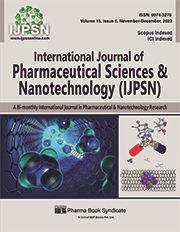A Review on Palmoplantar keratodermas
DOI:
https://doi.org/10.37285/ijpsn.2022.15.6.8Abstract
A palmoplantar keratoderma is a group of hereditary, keratinization disorders characterised by hyperkeratotic thickening of the palms and soles. PPK presents in three forms namely diffuse, focal & punctate. The aetiological factors of Palmoplantar keratoderma are drug-related, chemical-related, systemic disease-related, infection-related, & idiopathic. Palmoplantar keratodermas are diagnosed based on their clinical manifestations and forms. Tiny raindrop-shaped lesions, which are relatively uncommon in nature are one of the clinical symptoms of Type-I PPK. The papules are round and hyperkeratotic and the lesions are yellow to flesh-coloured, well-circumscribed, and firm to the touch. Type-II usually presents with small spines to protrude from the palms and soles whereas Type-III is characterised by tiny flat or umbilicated keratotic shining papules to form along the palms, soles, and digits borders. The prevalence of PPK is less among Indian populations hence managing these conditions might be more challenging due to limited treatment options. However, managing these conditions is based on the classifications and their presentation.
Downloads
Metrics
Keywords:
Palmoplantar, keratoderma, hereditary, keratin, differential diagnosisDownloads
Published
How to Cite
Issue
Section
References
Akiyama M, Ishida-Yamamoto, Kubo A, Nomura T, Suga Y, Yoneda K. Japanese guidelines for the management of palmoplantar keratoderma. J Dermatol.2021 Aug; 48(8): e353–367.
Anita L, Hofer.P.A, Holmgren G, Lisbet.L. The gene for diffuse palmoplantar keratoderma of the type found in Northern Sweden is localized to chromosome. 12q11-q13 Hum Mol Genet.1994 October 1; 3(10): 1789–93.
Athanikar S.B, Kikkeri N.N, Rao R, Sori T, Varadraj V.P. Type I punctate palmoplantar keratoderma (Buschke-Fisher-Brauer disease) in a family-A report of two cases.The Foot.(Edinb). 2012 Sep; 22(3): 240–2.
Archana S , Deepika P. D, Rithika G, Shilpa M. Hereditary punctate palmoplantar keratoderma (PPK) (Brauer-Buschke-Fischer Syndrome). J Dermatol. 2004 May ; 31(5): 398–402.
Bodemer C, Mazereeuw-Hautier. J, Steijlen. P and Toole E.A.O. Treatment of hereditary palmoplantar keratoderma: a review by analysis of the literature. Br J Dermatol.2021 March; 184(3): 393–400.
Braun-Falco M. Hereditäre Palmoplantarhyperkeratosen.Journal of the German Society of Dermatology.2009 Ocotber 22; 7(11): 971–984.
Challa A, Marwaha R. K, Ramakrishnan L, Thulkar S, Sethuraman G, Yenamandra V.K. Vitamin D: A new promising therapy for congenital ichthyosis. American Academy of Pediatrics.2016 Jan; 137(1): 2015-1313
Cristina H, Kristin T.H.Palmoplantar keratodermas: clinical and genetic aspects. J Dtsch Dermatol Ges.2016 Feb; 14(2): 123–40.
Dekeuleneer V , Herzinger T, Karthin A.G, Sárdy M, Von Braunmühl T, Wolff H. Eight novel mutations confirm the role of AAGAB in punctate palmoplantar keratoderma type 1 (Buschke-Fischer-Brauer) and show broad phenotypic variability. Acta Derm Venereol. 2016; 96(4): 468–72.
Emmert S, Giehl K, Hennies H.C, Schiller S, Seebode C. Palmoplantare Keratosen (PPK): Erworbene und genetische Ursachen eines gar nicht so seltenen Krankheitsbildes. Journal of the German Society of Dermatology.2014 Sep; 12(9): 781–8.
English J.C , Shaily P, Zirwas M. Acquired palmoplantar keratoderma. Am J Clin Dermatol.2007; 8(1): 1–11.
Gomathy.S, Tanvi Dev, Vikram K.H. Hereditary Palmoplantar Keratoderma.A Practical Approach to the Diagnosis Indian.Dermatol Online J. 2019 July- August; 10(4): 365–379.
Horikoshi M, Kuroda K, Tajima S.Punctate palmoplantar keratoderma with pigmentary lesions on the dorsa of feet and ankles successful treatment with a combination of low-dose oral etretinate and topical calcipotriol. J.Dermatol. 2004 Jun; 31(6): 469–72.
Infusino S.D, Kasapi E, Passarini B. Chloracne: Still cause for concern. Dermatology.2010 Aug; 221(1): 63–70.
Jeevankumar B, Karthikeyan K, Thappa D.M. Pattern of Pediatric Dermatoses in a Referral Center in South India. Indian Pediatr. 2004; April 41(4): 373–7.
Jeong W.J, Jeong D.S,Kim C.Y.Case of pucnctate palmoplantar keratoderma type I treated with combination of low-dose oral acitretin and topical salicylic acid and steroid . Journal of Dermatology. 2018 March 03; 45(5): 609–12
Joseph C.E , Matthew Z, Shaily. P. Acquired palmoplantar keratoderma. Am J Clin Dermatol.2007; 8(1): 1–11.
Kubo A, Sakiyama T, A. Hereditary palmoplantar keratoderma clinical and genetic differential diagnosis. Journal of Dermatology.2016 March; 43(3): 264–74.
Mills C.M, Marks R. Adverse Reactions to Oral Retinoids. An Update Drug Safety.1993 October; 9(4): 280–90.
Pasmooij A.M.G.Topical Gentamicin for the Treatment of Genetic Skin Diseases. J Invest Dermatol.2018 April; 138(4): 731–4.
Uitto J, Richard G, McGrath, J. A. disaeases of epidermal keratins and their liner protiens .Exp Cell Res. 2007 June 10; 313(10): 1995-2009






